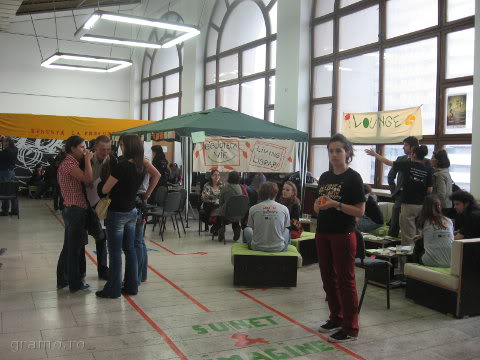Noroc cu articolul Andrei, altfel nu ajungeam la chestia asta.

E titlul unei lucrari artistice realizate de Franco Losvizzero (anul trecut a primit premiul Celeste). Vine de la un cantec pentru copii in italiana:
Giro Giro Tondo,
Quanto è bello il mondo!
Cento, cinquanta,
La gallina canta.
Canta da sola,
Non vuole andare a scuola.
Ma la scuola è tanto bella.
Canta canta gallinella!
(sursa aici)
Iar mai jos aveti si un film de la expozitie, daca vreti sa vedeti despre ce e vorba. E NSFW, dar e un film destul de frumos. Coloana sonora, in orice caz, ni s-a parut foarte faina (asa ca daca sunteti pudici, puteti asculta doar sunetul, cu ochii inchisi 🙂 ).
This might sound at a point like a ragtime, but don’t be fooled – it’s a piano sonata nevertheless. 🙂 The last one written by Beethoven (and his last composition for piano too). So here goes the last “concert” from this series (we hope you’ve enjoyed it):
As usual, we want to thank Bunji Hisamori for his kind permission to post the above audio rendering on our blog. The midi file was downloaded from The Classical Music Archives. You can find some technical details and the previous sonatas from this series here.
Ideea e urmatoarea. Mai intai citim despre un eveniment (sau un subiect de stire), dupa care incercam sa ne inchipuim cum ar fi scris presa din Romania despre evenimentul respectiv. Daca vreti, puteti sa jucati rolul unui anumit ziar sau chiar al unui anumit jurnalist. Nu vrem sa jignim pe nimeni, ci doar sa ne amuzam.
Primul subiect pe care vi-l propunem e un spectacol de dans modern – Pâquerette (jucat de François Chaignaud si Cecilia Bengolea). Beware, chestiile care urmeaza sunt NSFW!
This sonata was composed by Beethoven in 1821 and has three parts. It is, in a way, representative for the group of piano sonatas written by him at the end of his life (he had probably lost his hearing entirely at the time).
As usual, we want to thank Bunji Hisamori for his kind permission to post the above audio rendering on our blog. The midi file was downloaded from The Classical Music Archives. You can find some technical details and the previous sonatas from this series here.
E un mash up realizat folosind inregistrarile trimise de cei care au candidat pentru YouTube Symphony Orchestra. A aparut azi pe YouTube si arata cam asa:
p.s.: Orchestra YouTube o sa cante azi live la Carnegie Hall, sub conducerea lui Michael Tilson Thomas.
LE: Prima parte a concertului e aici.
Noi vrem sa mergem luni si marti, de la 6 seara. Miercuri nu stim daca o sa mai reusim sa ajungem, fiindca s-ar putea sa ni-l aduca bunicii pe Razvan. N-am facut rezervare decat pentru un loc, fiindca n-am apucat sa ne facem decat un cont, dar sistemul pare sa functioneze. Anyway, poate ne vedem pe acolo.
This is quite intense:
As usual, we want to thank Bunji Hisamori for his kind permission to post the above audio rendering on our blog. The midi file was downloaded from The Classical Music Archives. You can find some technical details and the previous sonatas from this series here.
The 29th piano sonata (also called Große Sonate für das Hammerklavier) is one of the most difficult works for piano solo ever written by man. It is a bit long, though, so make sure you have about 40 minutes to spare before you start listening to it.
As usual, we want to thank Bunji Hisamori for his kind permission to post the above audio rendering on our blog. The midi file was downloaded from The Classical Music Archives. You can find some technical details and the previous sonatas from this series here.
You can actually hear how much Beethoven’s musical thinking has evolved while you listen to this sonata. If you compare it to the first piano sonata written by Beethoven more than 20 years earlier, for instance, you’ll see what we mean. It’s musical structure is more complex and sounds at times a bit broken, a bit repetitive, as it expresses what Beethoven has called “a series of impressions and reveries” (see here).
However, the 28th is still an interesting listening experience, so we hope you’ll enjoy it:
As usual, we want to thank Bunji Hisamori for his kind permission to post the above audio rendering on our blog. The midi file was downloaded from The Classical Music Archives. You can find some technical details and the previous sonatas from this series here.